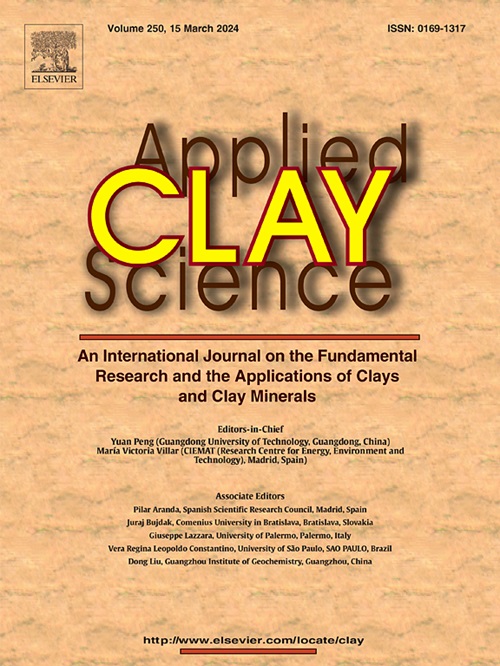Eco-friendly composite materials of polybutylene succinate with clay minerals, lignin and canabrava fiber
IF 5.3
2区 地球科学
Q2 CHEMISTRY, PHYSICAL
引用次数: 0
Abstract
The widespread use of plastics in seedling production, due to their convenience and cost-effectiveness, poses significant environmental challenges, including pollution and high resource consumption. To address these issues, a sustainable hybrid bio-composite was developed using bio-polybutylene succinate (PBS) combined with canabrava fibers (Cana) (up to 30 wt%), lignin (Lig), montmorillonite (MMT), and sepiolite (SEP). This bio-composite, featuring a negative carbon footprint and fully biodegradable components, offers a promising alternative to polypropylene packaging in seedling production, enhancing environmental sustainability and promoting the valorization of waste materials like Cana and Lig. The bio-composites were synthesized via melt blending in an extruder, and their mechanical, thermal, and morphological properties were evaluated. The melt flow rate could be effectively managed by adjusting the combination of Cana, Lig, and clays, achieving values comparable to polypropylene (EP440L). Notable enhancements in mechanical properties were observed relative to neat PBS, with increases in Young's modulus (up to 353 %), yield stress (up to 198 %), flexural modulus (up to 390 %), and flexural strength (up to 160 %). These improvements are mainly attributed to the high Cana fiber content and the hybrid effects of clays, particularly SEP. However, reductions in impact resistance and elongation were noted compared to neat PBS and EP440L, likely due to limited fiber-polymer interactions and increased compactness as observed in SEM analysis. FT-IR analysis indicated strong interactions between clays and PBS, evidenced by a shoulder at 1602–1608 cm−1. XRD analysis suggested the exfoliation of MMT, as indicated by the absence of the (001) plane reflection, although the high content of Cana may have mitigated some mechanical benefits. DSC analysis revealed increased crystallinity with the incorporation of Cana, Lig, and clays, likely driven by nucleation effects. The presence of SEP was associated with a secondary melting peak, indicating effective dispersion and interfacial crystal formation. Enhanced thermal stability was demonstrated by a higher temperature at 90 % mass loss compared to neat PBS. These findings suggest the bio-composite is a sustainable alternative for reducing plastic waste in seedling production.
聚丁二酸丁二醇酯与粘土矿物、木质素和大麻纤维的生态友好型复合材料
塑料因其便利性和成本效益而广泛应用于育苗生产,但也带来了巨大的环境挑战,包括污染和高资源消耗。为解决这些问题,我们开发了一种可持续的混合生物复合材料,它采用生物聚丁二酸丁二醇酯(PBS),并与 canabrava 纤维(Cana)(最高达 30 wt%)、木质素(Lig)、蒙脱石(MMT)和海泡石(SEP)结合使用。这种生物复合材料具有负碳足迹和完全可生物降解的特点,可在育苗生产中替代聚丙烯包装,增强环境的可持续性,并促进卡纳纤维和木质素等废弃材料的价值提升。生物复合材料是在挤压机中通过熔融混合合成的,并对其机械、热和形态特性进行了评估。通过调整 Cana、Lig 和粘土的组合,可有效控制熔体流速,使其达到与聚丙烯(EP440L)相当的数值。与纯 PBS 相比,机械性能显著提高,杨氏模量(高达 353%)、屈服应力(高达 198%)、弯曲模量(高达 390%)和弯曲强度(高达 160%)均有增加。这些改进主要归功于卡纳纤维的高含量和粘土(尤其是 SEP)的混合效应。不过,与纯净的 PBS 和 EP440L 相比,抗冲击性和伸长率有所降低,这可能是由于纤维与聚合物之间的相互作用有限以及 SEM 分析中观察到的密实度增加所致。傅立叶变换红外分析表明,粘土与 PBS 之间的相互作用很强,在 1602-1608 cm-1 处出现了肩峰。XRD 分析表明,尽管高含量的 Cana 可能减轻了某些机械性能,但 MMT 已剥离,这一点从没有出现 (001) 平面反射可以看出。DSC 分析表明,随着 Cana、Lig 和粘土的加入,结晶度增加,这可能是由于成核效应的驱动。SEP 的存在与次级熔化峰有关,表明有效的分散和界面晶体形成。与纯净的 PBS 相比,90% 质量损失时的温度更高,这表明热稳定性得到了增强。这些研究结果表明,生物复合材料是减少育苗过程中塑料废弃物的可持续替代品。
本文章由计算机程序翻译,如有差异,请以英文原文为准。
求助全文
约1分钟内获得全文
求助全文
来源期刊

Applied Clay Science
地学-矿物学
CiteScore
10.30
自引率
10.70%
发文量
289
审稿时长
39 days
期刊介绍:
Applied Clay Science aims to be an international journal attracting high quality scientific papers on clays and clay minerals, including research papers, reviews, and technical notes. The journal covers typical subjects of Fundamental and Applied Clay Science such as:
• Synthesis and purification
• Structural, crystallographic and mineralogical properties of clays and clay minerals
• Thermal properties of clays and clay minerals
• Physico-chemical properties including i) surface and interface properties; ii) thermodynamic properties; iii) mechanical properties
• Interaction with water, with polar and apolar molecules
• Colloidal properties and rheology
• Adsorption, Intercalation, Ionic exchange
• Genesis and deposits of clay minerals
• Geology and geochemistry of clays
• Modification of clays and clay minerals properties by thermal and physical treatments
• Modification by chemical treatments with organic and inorganic molecules(organoclays, pillared clays)
• Modification by biological microorganisms. etc...
 求助内容:
求助内容: 应助结果提醒方式:
应助结果提醒方式:


